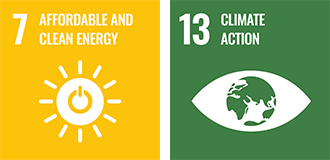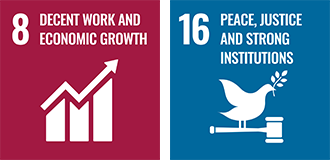Strategy and objectives
Ethics, integrity and responsibility are the guiding values in all our activities, in respect for people, the environment and the company as a whole
Driven by the desire to pursue responsible development of our business, we have defined an integrated strategy able to combine business growth and financial solidity with the principles of social and environmental sustainability, creating long-term value.
Sustainable growth, enhancement of human capital, reduction of direct and indirect environmental impacts and attention to social issues are the four areas of responsibility in which we have incorporated targets and projects for the responsible development of the group and our stakeholders.
In order to effectively incorporate the four strategic areas in all our activities, we have employed specific group policies.
The Group Sustainability Policy was created with the objective of governing our direct impacts, by identifying the roles, responsibilities and priority sustainability issues. Based on the 10 principles of the Global Compact, the Policy applies to all group companies, by integrating with all other guidelines, procedures, directives and provisions connected with the areas identified.
The priority themes of the Policy
The Group ESG Policy was drafted with the objective of effectively managing our indirect socio-environmental impacts, thanks to the integration of environmental, social and governance (ESG) criteria in our financing, investing and advisory model.
We want to build a responsible business, that integrates sustainability principles and objectives in all business activities. Policies and objectives, governance system, dialogue with stakeholders and adhesion to the Global Agenda form the basis of our commitment. In line with this commitment, we have defined some qualitative and quantitative objectives being set in the Strategic Plan 2023-2026 guidelines and included in the staff performance evaluation and remuneration policies for the Group’s entire corporate population and senior management in particular.
The targets identified, involve the following main topics:
Environmental

- Net Zero financed emissions by 2050
- 35% financed emissions intensity by 2030 (-18% by 2026))
- Interim sector targets for Net Zero Banking Alliance released by 20241
- Phase-out from coal by 20302
- Carbon neutrality on own emissions
- 100% renewable energy at Group leve
- Incorporating more “Climate & Environment” metrics into risk management processes such as RAF, ICAAP and Stress testing
- At least 2 Sustainability bond issues
1) No exposure to coal mining and agriculture. Four sector targets published by September 2023 (Automotive and Power already published; Cement and Aviation will be added). The remaining NZBA sectors will be disclosed by September 2024
2) In CIB lending (excluding Specialty Finance) and proprietary investment portfolio in all markets
Social

- >30% female members of MB Key Function Holders3
- >20% female executives
- >50% women out of total hires
- Parity in advancement rate
- 100% employees trained in ESG
- >€20m support to projects with social and environmental impact
- Stop lending to/investing in tobacco2
- 70% of procurement spending screened using ESG criteria
2) In CIB lending (excluding Specialty Finance) and proprietary investment portfolio in all markets
3) Key Function Holders: Group senior management
Governance

- Long-Term Incentive Plan featuring::
- 50% of total variable compensation (vs previous @20%) for Group CEO and General Manager delivered all in equity
- Extended to include other key Group strategic resources
- 20% assigned to ESG KPI weighting4
- Launch of the first Employee Share Ownership Plan to foster engagement and ownership at all levels
- Full adoption of Tax Control Framework for all the Group Italian banks
4) Two proposed KPIs to be included in the 2026 LTI: % of female executives; reduction in financed emissions intensity
The Plan objectives will be pursued by offering solutions, products and advisory services to support clients in the transition towards a sustainable economy, helped by training programmes and awareness-raising campaigns to promote increased sensitivity to ESG topics both within and outside the Group.
|
Wealth Management |
Consumer Finance | Corporate & Investment Banking |
|
|
|
1) % of ESG qualified funds (SFDR Articles 8&9 funds) out of total funds in clients’ portfolio
2) Number of ESG qualified funds (SFDR Articles 8&9 funds) manufactured by the Group Asset Managers
3) Cumulated figures over the 1 July 2023- 30 June 2026 period
|
≥35 million emails containing tips on green/financial education sent to clients by Compass
|
Engagement with clients to assist them in their decarbonization pathway
|
| ENVIRONMENT |
|---|
| OBJECTIVES TO 2026 | 30/06/24 | |
|---|---|---|
  |
35% financed emissions intensity (tCO2/M€) by 2030 (-18% by 20261) | -9.8% |
| All interim sector targets for NZBA | All NZBA sector targets set | |
| Carbon neutrality on own emissions2 | Carbon neutrality confirmed | |
| 100% renewable energy at Group level | 100% at Group level | |
| Phase-out from coal by 20303 | New ESG Policy broadening the perimeter to all lending portfolios | |
| Incorporating more “Climate & Environment” metrics into risk management processes such as RAF, ICAAP and Stress testing |
Ongoing |
| SOCIAL |
|---|
   |
|
|
| 100% employees trained in ESG | 84% | |
| >€20million5 support to projects with social and environmental impact | > €7 million | |
| Phase-out from tobacco by June 20263 | New ESG Policy approved broadening the perimeter to all lending portfolios | |
| 70% of procurement expenses screened with ESG criteria | 65% | |
| At least 2 Sustainability bond issuances | 1 issuance (€500m Sustainability SNP in September 2023) |
| GOVERNANCE |
|---|
  |
New Long-Term Incentive Plan featuring:
|
Approved in October 2023. ESG KPIs related to:
|
| Launch of the first Employee Share Ownership Plan to incentivize engagement and ownership at all levels | Launched | |
| Full adoption of Tax Control Framework for all the Group Italian banks | Tax Control Framework full adoption |
| OBJECTIVES TO 2026 | 30/06/24 |
|---|
| WEALTH MANAGEMENT |
|---|
| ESG OFFERING | >50% qualified funds6 in clients’ portfolio | 50% |
| +50% qualified funds production7 (+ 9 as at 30/06/2026) | +6 | |
| Share of green mortgages in new production to reach 19% | 11.5% out of total | |
| ESG CULTURE | 100% Wealth FAs certified in ESG by EFPA | 65% |
| 100% FAs trained ESG | 100% |
| CONSUMER FINANCE |
|---|
| ESG OFFERING | 15% CAGR ESG loans | +43% vs 30/06/2023 |
| ESG CULTURE | ≥ 35m emails containing tips on green/financial education sent to clients by Compass | 10m mails already sent |
| CORPORATE INVESTMENT BANKING |
|---|
| ESG OFFERING | Corporate finance: experienced dedicated Energy Transition advisory team | Set up and running |
| ESG DCM: 50% of originated8 bonds bearing ESG or ESG Linked features | 46% | |
| Lending: 40% Corporate ESG loans in new production8 bearing ESG or ESG Linked features | 38% | |
| ESG CULTURE | Engagement with clients to assist them in their decarbonization pathway | Ongoing and embedded into the Transition Plan |
1. In the CIB loan book, excluding Specialty Finance, vs 01/01/2023 emissions intensity (tCO2/M€). Because of the possible volatility that could derive from the gradual inclusion of Scope 3 category 11 “Use of sold products” in counterparties’ disclosures, it has been decided to exclude this impact from the calculation of emissions financed for the scope being analysed. This decision has been made only for those sectors defined as “enabling” the energy transition by Regulation (EU) no. 2020/852 (the “Taxonomy Regulation”), so as not to penalize those counterparties that contribute to the climate change objectives. However, the exclusion has not been applied to the sectors covered by the Net-Zero Banking Alliance objective.
2. Includes Scope 1 and Scope 2 market-based emissions.
3. In CIB lending (excluding Specialty Finance) and proprietary investment portfolio in all markets.
4. Key Function Holders: Group top management.
5. >€20million cumulated by 2026
6. % of ESG qualified funds (SFDR Articles 8&9 funds) out of total funds in clients’ portfolio
7. Number of ESG qualified funds (SFDR Articles 8&9 funds) manufactured by the Group Asset Managers.
8. Calculated over the 1 July 2023- 30 June 2026 period.
ESG: targets delivered, pathways improved
| CSR target in BP19/23 | FY23 delivery / Comments | ||
|---|---|---|---|
 |
Avg. training hours up 25%, to enhance employees’ competences |  |
Target widely exceeded each year |
 |
~50% of female candidates to be considered for external selections All suitable female candidates to be considered for internal promotions and/or vacancies |  |
Targets achieved New quantitative targets included in BP 2023-2026 |
 |
Asset Management: 100% of new investments screened also with ESG criteria €700m investments in Italian excellent SMEs % of ESG qualified funds (under SFDR, Art. 8&9) out of total funds in Affluent clients’ portfolio: 40% |  |
100% of new investments screened €480m investments in Italian excellent SMEs ~70% of ESG qualified funds |
 |
€4m per year in projects with positive social/environmental impact MB Social Impact Fund: AUM increase at least by 20% |  |
More than €26m in projects with social/environmental impact throughout the plan period AUM increased by more than 23% |
 |
Sustainable bond issue: €500m 40% of procurement expenses assessed with CSR criteria Customer satisfaction: CB! CSI¹ on core segment² @75, NPS¹ @30 - Compass: CSI @85, NPS @65 |  |
1 Green and 1 Sustainability bonds issued 62% of procurement expenses assessed CS targets widely exceeded each year |
 |
Energy3 : 92% from renewable sources, CO2 emissions down 11%; hybrid cars @72% of MB fleet RAM: first issue of a carbon neutral fund CheBanca! Green mortgages up 50% |  |
Emissions reduction and renewable sources targets achieved; hybrid cars @75% Carbon neutral fund issued Green mortgages +302% |
1) CSI: Customer Satisfaction Index; NPS: Net Promoter Score
2) Premier: clients with wealth between €50k and €5m
3) Target review: due to car delivery delays and still strong use fuel cards CO2 target has been reduced (down 11% vs down 27%) as well as the % of hybrid cars (72% vs 90% of MB fleet)





